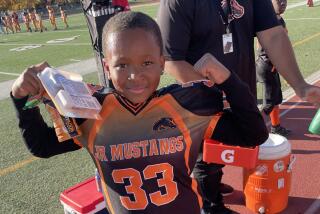A 6-Year-Old Knows Better, Doesn’t He?
- Share via
A 6-year-old is charged with the attempted murder of a 1-month-old baby in Richmond, Calif. It is an act that was carried out in the company of some buddies, a pair of 8-year-old twins. Family, community, state and nation are shocked. The mother of the 6-year-old makes a statement to the media: “My kid’s not a monster.” We wonder: Is this merely the natural reaction of maternal protectiveness, or is she right? Would the typical 6-year-old be capable of this act? If so, why have such acts been rare? And, most relevant to the administration of justice, to what degree can a 6-year-old be held responsible for an attempted murder?
UC Santa Cruz psychology professor Barbara Rogoff and her colleagues have noted that a shift in children’s competencies takes place between 5 and 7 years of age. That’s when children begin to become responsible for their own social behavior. This is the age at which they are considered rational and teachable, in possession of common sense. However, it is not until between 8 and 10 that children can be counted on to act competently, independently and responsibly. In theory, then, the 6-year-old in question had begun the transition to social and personal responsibility, but it was not yet complete. Five- to 7-year-olds are given responsibilities, but they are still supervised. It is reported that this Richmond child lacked such supervision. Along with his 8-year-old friends, neighbors said, he wandered the streets into the evening hours.
The boy is charged with attempted murder because, according to prosecutor Harold Jewett, neighbors said he had “previously expressed the belief that the family there had been harassing him, looked at him the wrong way, and he had to kill the baby.” In other words, planning seems to be involved.
What do we know about a 6-year-old’s planning skills? They have mostly been studied in play or staged situations. Although such situations are very different from attempted murder, they do show us that planning ability takes a leap forward when a child reaches age 6. A study found that 3-year-olds confronted with a maze, do not plan their route; they simply jump in and act. However, between age four and six, about 50% of the time, children scan the maze to see what barriers lie ahead. This planning enables them to succeed, whereas the 3-year-olds fail. Another study found that for kindergarten children, sharing responsibility with a peer in a planning task led to more effective action than simply working alone. So, the typical 6-year-old has begun to develop planning skills that can be enhanced by the collaborative participation of peers. These were the conditions in Richmond.
What about the development of aggressive behavior? While toddlers are limited to instrumental aggression--aggression directed at obtaining something desirable--by the age of 6, the development of hostile or “person-oriented” aggression is complete. This kind of aggression is more specifically aimed at hurting another person, either for revenge or as a way of establishing dominance. Clinicians report that children of this age sometimes express hostility by killing pets.
What conditions would elicit this kind of aggression from a 6-year-old? According to research, when parents have difficulty controlling their own anger and hostility, children tend to have problems as well. The mother of the Richmond boy fits this description. It was reported that in August 1995, the police were called for an incident in which she had a bloody brawl with three other women. The child may not have understood the consequences of similar actions for a month-old baby.
Capabilities aside, what would such an act mean to a 6-year-old morally? At this age, children are dependent on the external world, on the teachings and examples of authority figures, for their concepts of right and wrong and for their social behavior. Because the children in question were known to spend much of their time alone, partly because of working or ill mothers and deceased fathers, such influences may have been inadequate.
Another element is what death may mean to a 6-year-old. Even though the boy said he wanted to kill the baby, he may well not have understood what that meant in the same way adults would. We know that young children do not have an idea of the permanence of death. A child, around 7, engaged in normal sibling rivalry, was heard to say, “Let me kill him just once,” according to Los Angeles-based developmental psychologist Susan Braunwald. Another child of 6 begged her mother to make her dead cat come back to life. When her mother said no one could do that, the child replied “Get a person who’s magic to make her back.”
We do not know what happened in that bedroom in Richmond. We do not know what was in the mind of the 6-year-old. But we do have knowledge about the joint influences of chronological age and environment that could be relevant to averting future tragedies of the same sort.
More to Read
Sign up for Essential California
The most important California stories and recommendations in your inbox every morning.
You may occasionally receive promotional content from the Los Angeles Times.










